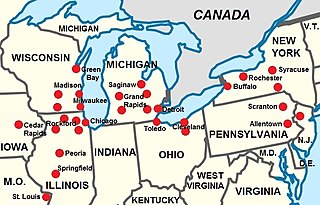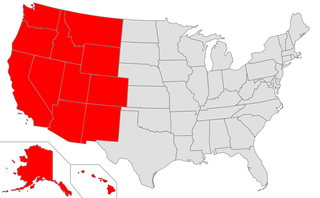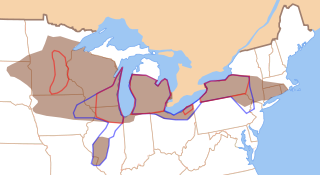American English, sometimes called United States English or U.S. English, is the set of varieties of the English language native to the United States. English is the most widely spoken language in the United States and in most circumstances is the de facto common language used in government, education and commerce. It is also the official language of most US states. Since the late 20th century, American English has become the most influential form of English worldwide.
North American English is the most generalized variety of the English language as spoken in the United States and Canada. Because of their related histories and cultures, plus the similarities between the pronunciations (accents), vocabulary, and grammar of American English and Canadian English, the two spoken varieties are often grouped together under a single category. Canadians are generally tolerant of both British and American spellings, with British spellings of certain words being favored in more formal settings and in Canadian print media; for some other words the American spelling prevails over the British.
General American English, known in linguistics simply as General American, is the umbrella accent of American English spoken by a majority of Americans, encompassing a continuum rather than a single unified accent. In the United States it is often perceived as lacking any distinctly regional, ethnic, or socioeconomic characteristics, though Americans with high education, or from the North Midland, Western New England, and Western regions of the country are the most likely to be perceived as using General American speech. The precise definition and usefulness of the term continue to be debated, and the scholars who use it today admittedly do so as a convenient basis for comparison rather than for exactness. Other scholars prefer the term Standard American English.
The phonology of the open back vowels of the English language has undergone changes both overall and with regional variations, through Old and Middle English to the present. The sounds heard in modern English were significantly influenced by the Great Vowel Shift, as well as more recent developments in some dialects such as the cot–caught merger.
Southern American English or Southern U.S. English is a regional dialect or collection of dialects of American English spoken throughout the Southern United States, though concentrated increasingly in more rural areas, and spoken primarily by White Southerners. In terms of accent, its most innovative forms include southern varieties of Appalachian English and certain varieties of Texan English. Popularly known in the United States as a Southern accent or simply Southern, Southern American English now comprises the largest American regional accent group by number of speakers. Formal, much more recent terms within American linguistics include Southern White Vernacular English and Rural White Southern English.
A Boston accent is a local accent of Eastern New England English, native specifically to the city of Boston and its suburbs. Northeastern New England English is classified as traditionally including New Hampshire, Maine, and all of eastern Massachusetts, though some uniquely local vocabulary appears only around Boston. A 2006 study co-authored by William Labov claims that the accent remains relatively stable, though a 2018 study suggests the accent's traditional features may be retreating, particularly among the city's younger residents, and becoming increasingly confined to the historically Irish American neighborhood of South Boston.
Eastern New England English, historically known as the Yankee dialect since at least the 19th century, is the traditional regional dialect of Maine, New Hampshire, and the eastern half of Massachusetts. Features of this variety once spanned an even larger dialect area of New England, for example, including the eastern halves of Vermont and Connecticut for those born as late as the early twentieth century. Studies vary as to whether the unique dialect of Rhode Island technically falls within the Eastern New England dialect region.
In English, many vowel shifts affect only vowels followed by in rhotic dialects, or vowels that were historically followed by that has been elided in non-rhotic dialects. Most of them involve the merging of vowel distinctions and so fewer vowel phonemes occur before than in other positions of a word.
Philadelphia English or Delaware Valley English is a variety or dialect of American English native to Philadelphia and extending into Philadelphia's metropolitan area throughout the Delaware Valley, including southeastern Pennsylvania, counties of northern Delaware, the northern Eastern Shore of Maryland, and all of South Jersey, with the dialect being spoken in cities such as Wilmington, Atlantic City, Camden, Vineland, and Dover. Philadelphia English is one of the best-studied types of English, as Philadelphia's University of Pennsylvania is the home institution of pioneering sociolinguist William Labov. Philadelphia English shares certain features with New York City English and Midland American English, although it remains a distinct dialect of its own. Philadelphia and Baltimore accents together fall under what Labov describes as a single "Mid-Atlantic" regional dialect.
North American English regional phonology is the study of variations in the pronunciation of spoken North American English —what are commonly known simply as "regional accents". Though studies of regional dialects can be based on multiple characteristics, often including characteristics that are phonemic, phonetic, lexical (vocabulary-based), and syntactic (grammar-based), this article focuses only on the former two items. North American English includes American English, which has several highly developed and distinct regional varieties, along with the closely related Canadian English, which is more homogeneous geographically. American English and Canadian English have more in common with each other than with varieties of English outside North America.
The cot–caught merger, also known as the LOT–THOUGHT merger or low back merger, is a sound change present in some dialects of English where speakers do not distinguish the vowel phonemes in words like cot versus caught. Cot and caught is an example of a minimal pair that is lost as a result of this sound change. The phonemes involved in the cot–caught merger, the low back vowels, are typically represented in the International Phonetic Alphabet as and, respectively. The merger is typical of most Canadian and Scottish English dialects as well as some Irish and U.S. English dialects.

Inland Northern (American) English, also known in American linguistics as the Inland North or Great Lakes dialect, is an American English dialect spoken primarily by White Americans in a geographic band reaching from the major urban areas of Upstate New York westward along the Erie Canal and through much of the U.S. Great Lakes region. The most distinctive Inland Northern accents are spoken in Chicago, Milwaukee, Detroit, Cleveland, Buffalo, Rochester, and Syracuse. The dialect can be heard as far west as eastern Iowa and even among certain demographics in the Twin Cities, Minnesota. Some of its features have also infiltrated a geographic corridor from Chicago southwest along historic Route 66 into St. Louis, Missouri; today, the corridor shows a mixture of both Inland North and Midland American accents. Linguists often characterize the western Great Lakes region's dialect separately as North-Central American English.

Western American English is a variety of American English that largely unites the entire Western United States as a single dialect region, including the states of California, Nevada, Arizona, Utah, New Mexico, Colorado, and Wyoming. It also generally encompasses Washington, Oregon, Idaho, and Montana, some of whose speakers are classified additionally under Pacific Northwest English.

Midland American English is a regional dialect or super-dialect of American English, geographically lying between the traditionally-defined Northern and Southern United States. The boundaries of Midland American English are not entirely clear, being revised and reduced by linguists due to definitional changes and several Midland sub-regions undergoing rapid and diverging pronunciation shifts since the early-middle 20th century onwards.

Northern American English or Northern U.S. English is a class of historically related American English dialects, spoken by predominantly white Americans, in much of the Great Lakes region and some of the Northeast region within the United States. The North as a super-dialect region is best documented by the 2006 Atlas of North American English (ANAE) in the greater metropolitan areas of Connecticut, Western Massachusetts, Western and Central New York, Northwestern New Jersey, Northeastern Pennsylvania, Northern Ohio, Northern Indiana, Northern Illinois, Northeastern Nebraska, and Eastern South Dakota, plus among certain demographics or areas within Michigan, Wisconsin, Minnesota, Vermont, and New York's Hudson Valley. The ANAE describes that the North, at its core, consists of the Inland Northern dialect and Southwestern New England dialect.
The sound system of New York City English is popularly known as a New York accent. The New York metropolitan accent is one of the most recognizable accents of the United States, largely due to its popular stereotypes and portrayal in radio, film, and television. Several other common names exist for the accent, associating it with more specific locations in the New York City area, such as a Bronx accent, Brooklyn accent, Queens accent, Long Island accent, or North Jersey accent; however, no research has demonstrated significant linguistic differences between these locations.
Rhoticity in the English language is the pronunciation of the historical rhotic consonant in certain contexts by English speakers. The presence or absence of rhoticity is one of the most prominent distinctions by which varieties of English can be classified. In rhotic accents, the historical English sound is preserved in all pronunciation contexts. In non-rhotic accents, speakers no longer pronounce in postvocalic environments: when it is immediately after a vowel and not followed by another vowel. For example, in isolation, a rhotic English speaker pronounces the words hard and butter as /ˈhɑːrd/ and /ˈbʌtər/, but a non-rhotic speaker "drops" or "deletes" the sound and pronounces them as /ˈhɑːd/ and /ˈbʌtə/.
The Atlas of North American English: Phonetics, Phonology and Sound Change is a 2006 book that overviews the pronunciation patterns (accents) in all the major dialect regions of the English language as spoken in urban areas of the United States and Canada. It is the result of a large-scale survey by linguists William Labov, Sharon Ash, and Charles Boberg. Speech data was collected, mainly during the 1990s, by means of telephone interviews with individuals in metropolitan areas in all regions of the U.S. and Canada. Using acoustic analysis of speech from these interviews, ANAE traces sound changes in progress in North American English, and defines boundaries between dialect regions based on the different sound changes taking place in them.

Standard Canadian English is the largely homogeneous variety of Canadian English that is spoken particularly across Ontario and Western Canada, as well as throughout Canada among urban middle-class speakers from English-speaking families, excluding the regional dialects of Atlantic Canadian English. Canadian English has a mostly uniform phonology and much less dialectal diversity than neighbouring American English. In particular, Standard Canadian English is defined by the cot–caught merger to and an accompanying chain shift of vowel sounds, which is called the Canadian Shift. A subset of the dialect geographically at its central core, excluding British Columbia to the west and everything east of Montréal, has been called Inland Canadian English. It is further defined by both of the phenomena that are known as Canadian raising : the production of and with back starting points in the mouth and the production of with a front starting point and very little glide that is almost in the Canadian Prairies.
Western New England English refers to the varieties of New England English native to Vermont, Connecticut, and the western half of Massachusetts; New York State's Hudson Valley also aligns to this classification. Sound patterns historically associated with Western New England English include the features of rhoticity, the horse–hoarse merger, and the father–bother merger, none of which are features traditionally shared in neighboring Eastern New England English. The status of the cot–caught merger in Western New England is inconsistent, being complete in the north of this dialect region (Vermont), but incomplete or absent in the south, with a "cot–caught approximation" in the middle area.
![Northeastern (NENE), Northwestern (NWNE), Southwestern (SWNE), and Southeastern (SENE) New England English represented here, as mapped by the Atlas of North American English on the basis of data from major cities
.mw-parser-output .hidden-begin{box-sizing:border-box;width:100%;padding:5px;border:none;font-size:95%}.mw-parser-output .hidden-title{font-weight:bold;line-height:1.6;text-align:left}.mw-parser-output .hidden-content{text-align:left}
Dialect definitions
NENE is defined by:
Widespread non-rhoticity
Full cot-caught merger - [a~a]
Full or transitional horse-hoarse merger
No father-bother merger: [a~a]
vs. [a~a]
/ar/
- [a(r)~a(r)]
NWNE is defined by:
Widespread rhoticity
Full cot-caught merger - [a]
Full horse-hoarse merger
Full father-bother merger - [a~a]
/ar/
- [ar~ar]
SWNE is defined by:
Widespread rhoticity
No or transitional cot-caught merger: [a~a]
vs. [a]
Full horse-hoarse merger
Full father-bother merger - [a~a]
/ar/
- [ar]
SENE is defined by:
Widespread non-rhoticity
No cot-caught merger: [a~a]
vs. [o@]
Full horse-hoarse merger
Full father-bother merger - [a~a]
/ar/
- [a(r)] New England English map.jpg](http://upload.wikimedia.org/wikipedia/commons/thumb/f/f0/New_England_English_map.jpg/220px-New_England_English_map.jpg)




